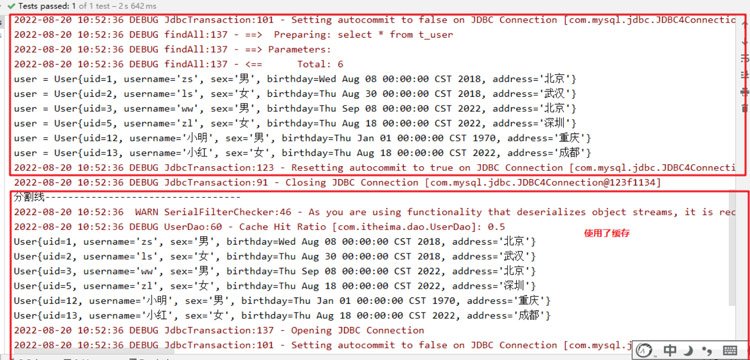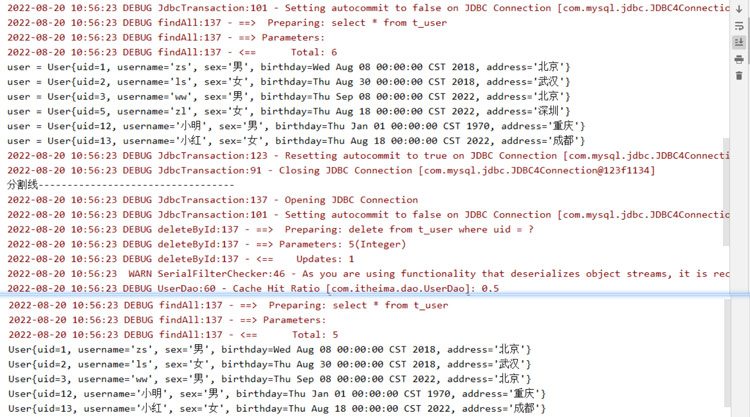How to use the second-level cache of Mybatis in Java
Overview and classification of cache
Overview
Cache is a piece of memory space that saves temporary data
Why use Cache
Read the data from the data source (database or file) and store it in the cache. When retrieving it, obtain it directly from the cache, which can reduce the number of interactions with the database, which can improve the performance of the program. Performance!
Applicability of cache
Suitable for cache: frequently queried but not frequently modified (eg: provinces, cities, category data), the accuracy of the data has no impact on the final result Big
Not suitable for caching: frequently changing data, sensitive data (for example: stock market prices, bank exchange rates, money in bank cards), etc.
MyBatis Cache Category
Level 1 cache: It is the cache of the sqlSession object. It comes with it (no configuration required) and cannot be uninstalled (if you don’t want to use it). The life cycle of the first level cache is consistent with sqlSession.
Second level cache: It is the cache of SqlSessionFactory. As long as the SqlSession created by the same SqlSessionFactory shares the contents of the second-level cache, it can operate the second-level cache. If we want to use the second-level cache, we need to manually enable it ourselves (configuration is required).
Use of second-level cache
1. Enable the second-level cache in the core configuration file of mybatis
<!--**因为 cacheEnabled 的取值默认就为 true**,所以这一步可以省略不配置。为 true 代表开启二级缓存;为 false 代表不开启二级缓存。 -->
<settings>
<setting name="cacheEnabled" value="true"/>
</settings>2. Configure the use of the second-level cache in the Dao mapping file
<?xml version="1.0" encoding="UTF-8" ?>
<!DOCTYPE mapper
PUBLIC "-//mybatis.org//DTD Mapper 3.0//EN"
"http://mybatis.org/dtd/mybatis-3-mapper.dtd">
<mapper namespace="com.itheima.dao.UserDao">
<!--配置二级缓存-->
<cache/>
<select id="findAll" resultType="user">
select * from t_user
</select>
<delete id="deleteById" parameterType="int">
delete from t_user where uid=#{id}
</delete>
</mapper>3. The Pojo class for second-level caching must implement the Serializable interface
public class User implements Serializable {
private int uid;
private String username;
private String sex;
private Date birthday;
private String address;
// 省略setter,getter,构造...等方法
}4. Test the use of second-level cache
Test code
@Test
public void testFindAll() throws Exception{
// 1.加载mybatis核心配置文件
InputStream is = Resources.getResourceAsStream("SqlMapConfig.xml");
// 2.创建SqlSessionFactoryBuilder对象
SqlSessionFactoryBuilder sqlSessionFactoryBuilder = new SqlSessionFactoryBuilder();
// 3.构建SqlSessionFactory对象
SqlSessionFactory sqlSessionFactory = sqlSessionFactoryBuilder.build(is);
// 4.获取SqlSession对象
SqlSession sqlSession = sqlSessionFactory.openSession();
// 5.获得dao接口的代理对象
UserDao userDao = sqlSession.getMapper(UserDao.class);
// 6.执行sql语句,得到结果
List<User> list = userDao.findAll();
for (User user : list) {
System.out.println("user = " + user);
}
sqlSession.close();//清除一级缓存
System.out.println("分割线----------------------------------");
SqlSession sqlSession2 = sqlSessionFactory.openSession();
UserDao userDao2 = sqlSession2.getMapper(UserDao.class);
List<User> userList2 = userDao2.findAll();
for (User user : userList2) {
System.out.println(user);
}
// 7.释放资源
sqlSession2.close();
}- Test results:

#- After the above test, we found that two queries were executed, and after executing the first query, we turned off the first-level cache and then went to When executing the second query, we found that no SQL statement was issued to the database, so the data at this time can only come from what we call the second-level cache.
5. Test to turn off the second-level cache
-Test code
@Test
public void testFindAll() throws Exception{
// 1.加载mybatis核心配置文件
InputStream is = Resources.getResourceAsStream("SqlMapConfig.xml");
// 2.创建SqlSessionFactoryBuilder对象
SqlSessionFactoryBuilder sqlSessionFactoryBuilder = new SqlSessionFactoryBuilder();
// 3.构建SqlSessionFactory对象
SqlSessionFactory sqlSessionFactory = sqlSessionFactoryBuilder.build(is);
// 4.获取SqlSession对象
SqlSession sqlSession = sqlSessionFactory.openSession();
// 5.获得dao接口的代理对象
UserDao userDao = sqlSession.getMapper(UserDao.class);
// 6.执行sql语句,得到结果
List<User> list = userDao.findAll();
for (User user : list) {
System.out.println("user = " + user);
}
sqlSession.close();//清除一级缓存
System.out.println("分割线----------------------------------");
SqlSession sqlSession2 = sqlSessionFactory.openSession();
UserDao userDao2 = sqlSession2.getMapper(UserDao.class);
userDao2.deleteById(5);// 关闭二级缓存
List<User> userList2 = userDao2.findAll();
for (User user : userList2) {
System.out.println(user);
}
// 7.释放资源
sqlSession2.close();
}-Test result

After the above Testing, we found that two queries were executed, and after executing the first query, we closed the first-level cache and the second-level cache. When we executed the second query, we found that a sql statement was issued to the database, so The data at this time comes from the database, not the cache.
The above is the detailed content of How to use the second-level cache of Mybatis in Java. For more information, please follow other related articles on the PHP Chinese website!

Hot AI Tools

Undresser.AI Undress
AI-powered app for creating realistic nude photos

AI Clothes Remover
Online AI tool for removing clothes from photos.

Undress AI Tool
Undress images for free

Clothoff.io
AI clothes remover

Video Face Swap
Swap faces in any video effortlessly with our completely free AI face swap tool!

Hot Article

Hot Tools

Notepad++7.3.1
Easy-to-use and free code editor

SublimeText3 Chinese version
Chinese version, very easy to use

Zend Studio 13.0.1
Powerful PHP integrated development environment

Dreamweaver CS6
Visual web development tools

SublimeText3 Mac version
God-level code editing software (SublimeText3)

Hot Topics
 1658
1658
 14
14
 1415
1415
 52
52
 1309
1309
 25
25
 1257
1257
 29
29
 1231
1231
 24
24
 Break or return from Java 8 stream forEach?
Feb 07, 2025 pm 12:09 PM
Break or return from Java 8 stream forEach?
Feb 07, 2025 pm 12:09 PM
Java 8 introduces the Stream API, providing a powerful and expressive way to process data collections. However, a common question when using Stream is: How to break or return from a forEach operation? Traditional loops allow for early interruption or return, but Stream's forEach method does not directly support this method. This article will explain the reasons and explore alternative methods for implementing premature termination in Stream processing systems. Further reading: Java Stream API improvements Understand Stream forEach The forEach method is a terminal operation that performs one operation on each element in the Stream. Its design intention is
 PHP: A Key Language for Web Development
Apr 13, 2025 am 12:08 AM
PHP: A Key Language for Web Development
Apr 13, 2025 am 12:08 AM
PHP is a scripting language widely used on the server side, especially suitable for web development. 1.PHP can embed HTML, process HTTP requests and responses, and supports a variety of databases. 2.PHP is used to generate dynamic web content, process form data, access databases, etc., with strong community support and open source resources. 3. PHP is an interpreted language, and the execution process includes lexical analysis, grammatical analysis, compilation and execution. 4.PHP can be combined with MySQL for advanced applications such as user registration systems. 5. When debugging PHP, you can use functions such as error_reporting() and var_dump(). 6. Optimize PHP code to use caching mechanisms, optimize database queries and use built-in functions. 7
 PHP vs. Python: Understanding the Differences
Apr 11, 2025 am 12:15 AM
PHP vs. Python: Understanding the Differences
Apr 11, 2025 am 12:15 AM
PHP and Python each have their own advantages, and the choice should be based on project requirements. 1.PHP is suitable for web development, with simple syntax and high execution efficiency. 2. Python is suitable for data science and machine learning, with concise syntax and rich libraries.
 PHP vs. Other Languages: A Comparison
Apr 13, 2025 am 12:19 AM
PHP vs. Other Languages: A Comparison
Apr 13, 2025 am 12:19 AM
PHP is suitable for web development, especially in rapid development and processing dynamic content, but is not good at data science and enterprise-level applications. Compared with Python, PHP has more advantages in web development, but is not as good as Python in the field of data science; compared with Java, PHP performs worse in enterprise-level applications, but is more flexible in web development; compared with JavaScript, PHP is more concise in back-end development, but is not as good as JavaScript in front-end development.
 PHP vs. Python: Core Features and Functionality
Apr 13, 2025 am 12:16 AM
PHP vs. Python: Core Features and Functionality
Apr 13, 2025 am 12:16 AM
PHP and Python each have their own advantages and are suitable for different scenarios. 1.PHP is suitable for web development and provides built-in web servers and rich function libraries. 2. Python is suitable for data science and machine learning, with concise syntax and a powerful standard library. When choosing, it should be decided based on project requirements.
 Java Program to Find the Volume of Capsule
Feb 07, 2025 am 11:37 AM
Java Program to Find the Volume of Capsule
Feb 07, 2025 am 11:37 AM
Capsules are three-dimensional geometric figures, composed of a cylinder and a hemisphere at both ends. The volume of the capsule can be calculated by adding the volume of the cylinder and the volume of the hemisphere at both ends. This tutorial will discuss how to calculate the volume of a given capsule in Java using different methods. Capsule volume formula The formula for capsule volume is as follows: Capsule volume = Cylindrical volume Volume Two hemisphere volume in, r: The radius of the hemisphere. h: The height of the cylinder (excluding the hemisphere). Example 1 enter Radius = 5 units Height = 10 units Output Volume = 1570.8 cubic units explain Calculate volume using formula: Volume = π × r2 × h (4
 PHP's Impact: Web Development and Beyond
Apr 18, 2025 am 12:10 AM
PHP's Impact: Web Development and Beyond
Apr 18, 2025 am 12:10 AM
PHPhassignificantlyimpactedwebdevelopmentandextendsbeyondit.1)ItpowersmajorplatformslikeWordPressandexcelsindatabaseinteractions.2)PHP'sadaptabilityallowsittoscaleforlargeapplicationsusingframeworkslikeLaravel.3)Beyondweb,PHPisusedincommand-linescrip
 PHP: The Foundation of Many Websites
Apr 13, 2025 am 12:07 AM
PHP: The Foundation of Many Websites
Apr 13, 2025 am 12:07 AM
The reasons why PHP is the preferred technology stack for many websites include its ease of use, strong community support, and widespread use. 1) Easy to learn and use, suitable for beginners. 2) Have a huge developer community and rich resources. 3) Widely used in WordPress, Drupal and other platforms. 4) Integrate tightly with web servers to simplify development deployment.




